(New Instrument of Threes)
- page eight -
(The Study of Threes)
http://threesology.org
Reality, in terms of what we presently understand about human perception and responses to those perceptions; such as might be described by a body/mind duality with respect to each as a complement to one another; even though one might want to take up the position that such a duality can also be oppositional. Such oppositions are considered to be a self-evident logic which could alternatively be described as axiomatic, if this is your language preference.
Whereas Reality may exist as a singularity and each person's physiology a type of prism through which Reality "flows" or is filtered, this "singularity" is a type of kaleidoscopic array of sounds, sights and sensations which might be compared with or without combinations of alternating and direct currents.

Realty filtered through a person can produce either/or both colorful images or what might be described as "white noise", without attempting to be either representative of a racial mentality or disparaging since the one can denote focused intent; though the reader might want to be particularly negative instead of positive in their interpretation based on prejudices, biases or culturally-laden associations based on content derived movies, literature or conversation.
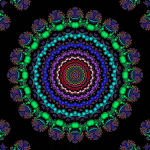
The usage of the word "noise" typically has negative connotations for many. But I am only offering an illustration for comparing, not contrasting in terms of one being good and the other being bad. This kaleidoscopic array of impressions of a given environment become arranged, to some extent, into one or more patterns through the processing system of the brain. If the processing system relies primarily on religious or superstitious channels called ideas, all information will "flow" as a process in accordance with these ideas.
However, though we call these ideas knowledge, the acquisition of knowledge can be understood as the result of a navigable system having dams, locks and various types of uncharted fluidic causeways. Like the expanse of an ocean that filters pollution by way of dilution for which some claim as a viable solution; other sources of fluidic flow could well filter poorly and act as a type of meshed trap like that put into a kitchen sink, inline with a garbage disposal, or various other types of oil, gas, air (solid, liquid, gas) filtering systems. Both our body and mind have filtering systems. While those in the body such as kidneys, hair in one's nose, skin, etc., are well known, those of the mind are not. Humanity's efforts thus far at unraveling the filtering systems remains in the realm of speculation utilizing metaphors and witch-doctor types of interpretation like psychology, religion, sociology, and political science, to name but a few, with their differing tools of human behavior divination. All of them, which includes stock market analysis, have their own form of logically rationalized stupidity.
In other words, Reality can act very much like an uncertainty principle if one's reality is primarily based on the presumptions of others without attempting to verify according to one's own merits of interpretation for validation, (and without them standing over your shoulder, paying for the venture, or being constrained by those wanting their ideas to be verified... at any cost).
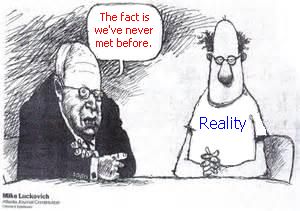
While both liquids and gases are termed fluidic in that they fill up the space of a container, we do not similarly and readily comprehend the same idea with respect to a solid. In a sense, it exists as a different singular (Monism) reality. Some may readily exist in two realities such as for example, in a vapor and liquid state, and others can readily exist in three realities such as a liquid, solid, and gas... such as water. Whereas liquids and gases might be viewed as flexible ideas, they are both compressible.
On the other hand, a solid is not "flexible" in similar terms unless it is made malleable by heat, though a weak acid or large pressure might do the same... in some regards. Conversely, liquids and gases are not typically considered to be representations of a solid, though limits to compressibility would suggest a solidification has taken place. Further more, If we compare the two fluidic substances with waves and the solid as a particle, then we are confronted with the wave/particle theory of quantum mechanics and consider that ideas can be both, simultaneously, liquid and solid... metaphorically speaking. But we should not discount the notion of an entity's existence that is neither or is both and another form that is presently unknown and be labeled the "U" to go along with the W(ave) and P(article) forms, even though the latter two are described as a complementary duality.
But such imaginative analogies may not be serviceable for all readers, so let me restate some basics as to how Reality is thought (generally) to be derived.
For example, a similar orientation illustrated differently is to say that the body receives environmental impressions that the mind interprets or responds in accordance with/to/because of:
- Basic sensations we label as (for example):
- pleasurable
- neutral
- painful
- Basic impulses we label as instincts (for example):
- Flight
- Freeze
- Fight
- Basic knowledge (for example):
- in a given individual
- in a given place
- in a given time
The foregoing are different filtering systems and no one appears to have the identically same filtering system. Just because you and I and a million other people agree to call a particular object a flower, does not mean any one us sees the same object in the same way... even if we say we do. We just agree that we do. The agreement thus comes to be noted as a shared reality. The flower has its own reality based on its biological means to respond to the environment which it inhabits, which may be a reality that has no ability to "recognize" our presence or the presence of many other things we humans do. But the same situation exists for us.
There quite probably exists a reality beyond not only our ability to perceive with respect to our particularly designed biology, but that we are incapable of perceiving even if we were able to design instrumentation to perceive it; because we design instrumentation based on what we can perceive, which includes notions that might be called metaphysical, assumptions, etc. Such a reality as to what I am referring, has not been labeled by any perspective in any culture in any time period. It is not heaven, it is not a dimension, it is not an indistinction; it is that which has never been named nor even thought of by anyone. It exists beyond our present grasp because we don't know how to think about it within any present system of thinking or means of expression. Many don't want to know it because they prefer to use the topic of an "unknown" as a means to convince one or more others that they are right in the way they presently think. If they can retain, perpetuate and possible enlarge a thought which presents a mystery, they will use it as a tool of manipulation that is referenced as a reality of an existing possibility. Such people are scoundrels.
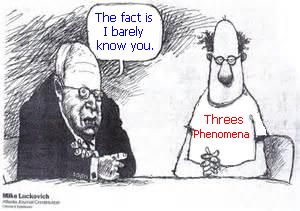
In fact there might be multiple (or only three) different realities, each with its own set of "Universal" laws to which some readers might then want to suggest a "larger" Reality in which all such "smaller" realities are contained. Yet, they don't recognize their usage of dichotomous thinking (larger versus smaller); and are quick to assume their resulting combination is a superior form of thought; not realizing they will have missed a point brought up in the present discussion. On the other hand, we might be able to perceive minute impressions of a different reality but never come to fully know it without some dramatic alteration in our physiology or philosophy or psychology, as differing tools of exploration, interpretation, and design. But such considerations should not keep us from trying to exceed all present forms of knowledge and thought processing, even if we are very much like a primitive who would not be able to make "heads or tails" out of a University lecture and prefer to make sense out of the world with our own mental tools.
Reality, whether or not this word accurately describes what it is or that we humans can (fumbly try to) illustrate, appears to offer us discernibly basic ways we can acquire knowledge for the purposes of thinking; even if the old ways of thinking about thinking generally focus on one or another models of an (oppositional) dichotomy such as the following examples taken from Dr. Warren's Psychology 461 (History and Systems of Psychology Outline) under the heading of "Persistent Dichotomies":
- Conscious mentalism - Unconscious mentalism: Emphasis on awareness of mental structure or activity vs. unawareness; coincides with rationalism - irrationalism dichotomy.
- Empiricism - Rationalism: Major, if not exclusive source of knowledge is experience vs. reason.
- Nativism - Empiricism: Thought and behavior emerges from innate structures vs. emerges from experiences.
- Behaviorism - Mentalism: Proper study of psychological focuses on objective content or on subjective content.
- Determinism - (Indeterminism) Nondeterminism: Human events completely determined by antecedents and explicable vs. determined but incompletely explicable vs. not determined.
- Functionalism - Structuralism: Psychology should describe adaptive activities vs. elemental classes and contents.
- Mechanism - Vitalism: Activities of living beings completely explicable by physiochemical constituents vs. not so explicable
- Molecularism - Molarism
- Monism - Dualism: Fundamental principle or entity in universe is of one kind vs. two kinds, mind and matter.
- Subjectivism - Objectivism: Introspective accounts of experience do, or do not, constitute valid data.
- Universalism - Relativism: Is the world an objective entity, the same for everyone, or is it relative to the perceiver?
See addendum comments below
These examples, though others could be provided, are forays into an attempted understanding of a socially proposed reality being constructed. And I say "being constructed" because they represent a portion of different bait and tackle used to try to "catch" (apprehend) a greater understanding of something for which most of us don't actually know or we wouldn't have so many questions about it. Psychology and Philosophy, just like Mathematics and Physics, can be compared with fishing and hunting expeditions with various moments surrendered to varying types of foraging such as a hunting and gathering technique used by collectors.
- But the reader should not lose sight of the fact that there are singular words which directly or indirectly illustrate a dichotomy such as Ambivalence, Contention, Oppositional, etc... and word association "tests" frequently accept the singularly stated opposite of a word as the "correct" word which should first come to one's mind as a response.
- And we should also point out the very many more simple dichotomies such as night/day, love/hate, warm/cold, male/female, right/wrong, here/there, etc., and to additionally note that dichotomies may be described as a dualism to denote a complement instead of a contention such as in the pairing of yin and yang. (Hence, the usage of a dualism - dichotomy distinction can be framed in an oppositional way.)
- And thirdly, psychology and philosophy as well, should both think in terms of a psychology and philosophy which resides outside current forms thereof, but that some people (maybe even all of us) have an impression thereof yet it is not understood as such. And in an effort to describe the existence of a possible existence thereof, current labels readily reached for such as "phenomena" and "metaphysic", tend to evoke images of suspicion, incredulity or some measure of mental impropriety instead of further consideration. For example, a primitive mind might well consider the observation of a plane or helicopter seen from a distance to be a "phenomena", though without this word in the primitive's culture, the person or others in the respective culture might resort to the usage of words which are equivalent to a usage of metaphysic, illusion or something of a sinister "sign".
Dichotomies might well be viewed as a binary code like the zeros and ones used as a basic, underlying computer language based on the electric on/off circuit. But stating such is not to be construed as an advocacy thereof. It is to highlight a recurring mindset that applies the two-patterned code and then uses the applications as a justification for continued usage thereof, but refuses to engage in reflective thinking to question its usage or why human consciousness fails to utilize a different pattern, if it at all recognizes such a pattern such as the "three". And yet, the reader may say they are attempting to do so but are nonetheless stuck in a dichotomous frame of thinking by simply contrasting the two with the three! In other words, they don't know how to think in terms of an actual "three", only a two that is split into thirds.
To simply exhort the premise that we utilize a pattern-of-two binary code because it has a practical functionality, which is amiable to a utility by which we can establish and advance a system of commercial enterprise, does not mean we are thus constrained to think solely in a similar fashion. Granted, that at this present time in history we do rely on the electric circuit and its "on/off" characteristic. For those who simply take advantage of what is available, this is enough for them. They don't care to think otherwise, if much at all. But those like myself who can not help to question this occurrence, we have a need to look elsewhere. We are explorers. We are not like those who prefer to sit around a pool side soaking up the sun. Our ideas about exploration are not limited to shopping at a new store or trying out something different to eat. Not only do we not want to be a couch potato, it is entirely offensive when people try to force, cajole or manipulate us into keeping them company in their pursuit of being entertained by those who are as stupid as themselves.
Here's a "bit" (no pun intended) of history concerning the binary code taken from a Wikipedia article:
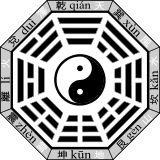
The modern binary number system, the basis for binary code, was discovered by Gottfried Leibniz in 1679 and appears in his article Explication de l'Arithmétique Binaire. The full title is translated into English as the "Explanation of the binary arithmetic", which uses only the characters 1 and 0, with some remarks on its usefulness, and on the light it throws on the ancient Chinese figures of Fu Xi." (1703). Leibniz's system uses 0 and 1, like the modern binary numeral system. Leibniz encountered the Yijing (or I-Ching) through French Jesuit Joachim Bouvet and noted with fascination how its hexagrams correspond to the binary numbers from 0 to 111111, and concluded that this mapping was evidence of major Chinese accomplishments in the sort of philosophical mathematics he admired. Leibniz saw the hexagrams as an affirmation of the universality of his own religious beliefs.
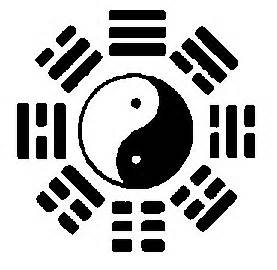
Interestingly, while the image shows three different lengths of lines, they were collectively looked at through a two-patterned (dichotomous) mindset to render a notion of long and short line combinations called, respectively, unbroken or broken. The distinction was made more difficult when the Daoist image was "translated" into modern Taoist perceptions which removed the lines out of the original configuration and placed them in a linear format which "aligned" the lines two produce a "balanced" symmetry. (Even though some people may use the words "Daoist and Taoist" interchangeably.) The previous "Daoist" image shows three different lengths of lines by being place in a sort of pyramidal fashion, whereas the "Taoist" image portrays the lines in a linear format which gives the impression of a balance. It's a balance alright. A visual balancing act which can distort perception and perspective, no matter which image is used.
But this form of balance is an illusion. It is an act of taking a dichotomy, proportioning it to the vagaries of one's own preferences, and then developing a three-patterned distinction that makes a statement which describes our personalized proportion as resulting in something real and superior to a dichotomy. Whereas this isn't wrong if it actually is superior, but to claim superiority by re-coloring a dichotomy to represent three proportions is not an actual "three" with respect to an independent status without reference or usage of a dichotomy (dualism). The two becomes a third but it is not a separately identifiable "three" entirely distinct from the two. In other words, it is not a different species. It is either an offspring, offshoot, or cast-off.
Addendum link from above:And let me also note that when the concept of "persistent dichotomies" is brought up, it should more rightly be term "persistent dichotomization", since examples of dichotomies may be era-specific. To present certain examples as occurring persistently, occludes the perception that different labels and interpretations thereof relate to time and place as well as language employed for description. The reader should not get it into their head that particular expressions are persistent from one generation to the next or even occur over what we of today as long passages of historical time. The concepts of Monism, Dualism and Triism are persisting with different labels as if they are re-creations of the old one - two - many words-for-numbers sequencing humanity utilized in the development of its quantitative number/symbol concepts. It's like a reduplicated babbling sequence and may signal either that the human brain is in a babbling stage of development or/and is "hung up" in terms of some obsessive-compulsion.
Return to List of Dichotomies
HTML (4.01) update: Monday, June 10, 2019... 4:54 AM
Your Questions, Comments or Additional Information are welcomed:
Herb O. Buckland
herbobuckland@hotmail.com